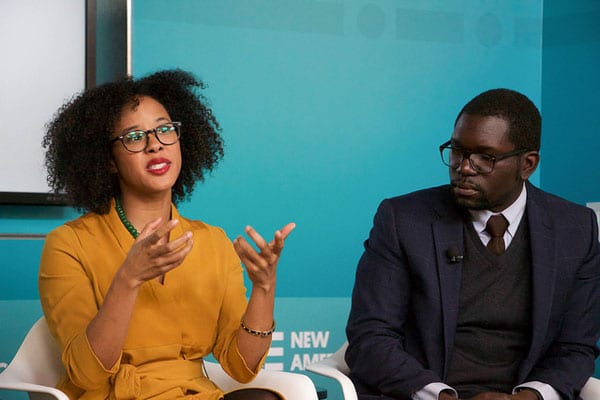
February 28, 2019; Vox, “Future Perfect”
I preface this newswire by urging readers to read the study by Megan Ming Francis from which it is drawn. It is well worth your time.
How do funders, even very well-meaning funders, redirect the course of social movements away from the strategies and narratives deemed important by the activists themselves? This is the basic question raised by an interesting study entitled “The Price of Civil Rights: Black Lives, White Funding, and Movement Capture.” Published in Law and Society Review, the article discusses the framework of “movement capture,” which author Megan Ming Francis, an associate professor in the Department of Political Science at the University of Washington, describes as the power of wealthy funders to change the priorities of a grassroots movement.
Francis does not demonize; she does justice to the funder in question by tracing its own intentions not to insert itself—originally—into direction-setting, but then with some care describes the processes by which that was baldly and persistently abridged.
“I’m concerned that sometimes even with the best of intentions, the priorities of the poorest and marginalized get replaced by the priorities of the rich and powerful,” she says, suggesting that Black emancipatory movements of today may be facing the same siren songs as the NAACP did as foundations seek to fund and perhaps alter their work.
On a larger level, the subtle redirecting effects of funders affect all types of nonprofits, so many readers will find this relevant. In this case, Francis, who also authored the award-winning Civil Rights and the Making of the Modern American State (2014), convincingly suggests that it may have played a part in altering the focus and course of the struggle for racial justice in the US. Her descriptions of the power-laden negotiations for the grant are searingly familiar even in current terms, as principal actors and narratives of that period are pushed slowly to the side to accommodate white-dominant institutions.
Francis has studied the effects of the relationship of the NAACP to the now-long-defunct Garland Fund in the early 20th century. She believes that the organization’s focus even now has been colored by Garland’s influence, which had the effect of moving the organization’s priorities away from fighting mob violence against black people to educational equity.
“Why does the protection of black bodies from private and state‐sanctioned violence remain an unmet challenge for civil rights groups committed to racial equality?” she asks in the study, “A major but under recognized reason…is directly connected to movement capture.”
From the viewpoint of the NAACP, before the organization could appropriately address other problematic areas of civil rights such as voting, labor, and housing, it was necessary to focus on ending lynching and mob violence. The NAACP, who viewed safety from mob violence and lynchings as the pinnacle civil rights struggle of the twentieth century, was severely underfunded by 1925 and without any viable prospects of big donors to support its anti‐lynching activism.
Sign up for our free newsletters
Subscribe to NPQ's newsletters to have our top stories delivered directly to your inbox.
By signing up, you agree to our privacy policy and terms of use, and to receive messages from NPQ and our partners.
It was in this context that the Garland Fund offered the largest grant ever made to the NAACP, but it was for pursuing civil rights in education. This, Francis argues, may have played a significant role in reshaping and directing the movement. As Francis writes,
The focus on education sidelined concerns of criminal procedure, siphoned resources away from the campaign around workers’ economic rights, and undermined the concerns of black labor. However, the campaign also had the effect of dramatically transforming constitutional law with the momentous Brown v. Board of Education decision. And even if it did not bring about direct change in education as many have alleged, it did have “cultural significance” which invigorated a new world of court‐centered and legislation‐centered civil rights claiming.
But might the outcome been better, might the movement have gotten further, had the organization been able to retain its original focus, the one for which it could not get sufficiently funded? This is an unanswerable question, but one clearly worth pondering.
Francis points to evidence that black leaders at the time didn’t think of desegregation as the pivotal success that we see it as today. Other researchers have emphasized that the fight for Brown was somewhat out of step with what black communities prioritized at the time.
[…]
They achieved this dramatic, important thing…but I do wonder about how different the trajectory of civil rights would have been if we’d listened to black activists at the time.”
Throughout this study, Francis talks about the ways in which narratives were essentially bought by those with power and money. She argues that you’ll see movement capture whenever there are private funders with different priorities than the organizations they’re funding, using their influence to redirect the organization’s focus and energy.
“That’s the conundrum of contemporary philanthropy,” she told Vox reporter Kelsey Piper. “It’s not bad that we have these so-called thought leaders. It’s not bad that there’s the work being done by [George] Soros, or by other groups, on work they think is genuinely important. But what was concerning back in the 1920s, and what I think is still concerning today, is the way that exciting localized social justice organizations get co-opted by funders.”—Ruth McCambridge













